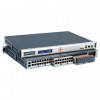Lantronix SLC 8000 Advanced Console Manager User Guide - Page 120
Performance Monitoring, To enable FIPS
 |
View all Lantronix SLC 8000 Advanced Console Manager manuals
Add to My Manuals
Save this manual to your list of manuals |
Page 120 highlights
Figure 6-14 Network > Security 6: Basic Parameters To enable FIPS: Note: The SSH client keyboard-interactive authentication type is not supported while the SLC unit is in FIPS mode. 1. Check the Enable FIPS Mode check box on the Networks > Security page. 2. Click Apply. The SLC unit will need to be rebooted to initiate FIPS mode. Once the SLC module is running in FIPS mode, the Security page, will display all processes that are running in FIPS mode. To disable FIPS: 1. Uncheck the Enable FIPS Mode check box on the Networks > Security page. 2. Click Apply. The SLC unit will need to be rebooted for this change to take effect. When rebooted after disabling FIPS mode, information about processes running in FIPS mode will no longer display on the Security page. Performance Monitoring The SLC supports Performance Monitoring probes for analyzing network performance. Probes for DNS Lookup, HTTP Get, ICMP Echo, TCP Connect, UDP Jitter and UDP Jitter VoIP are supported. Up to 15 different probes can be configured. Each probe will run a series of operations, each of which sends a series of packets to a destination host. The SLC will measure how long it took to receive a response, and record the results. For each operation, the user can view the results for each packet (round trip times), or the accumulated statistics for all packets - minimum, average and maximum latency, and for jitter probes, minimum, average, maximum and standard deviation of the jitter delay. Dropped packets and other error conditions are recorded for each operation. This capability allows an administrator to analyze network efficiency across the network. An operation consists of sending a specified number of packets to a destination host and optional port, with a specified amount of time between each packet. All results for each operation are stored in one data file, and the results can be viewed later. Accumulated statistics can also be pulled from the SLC via SNMP Gets. SLC™ 8000 Advanced Console Manager User Guide 120















